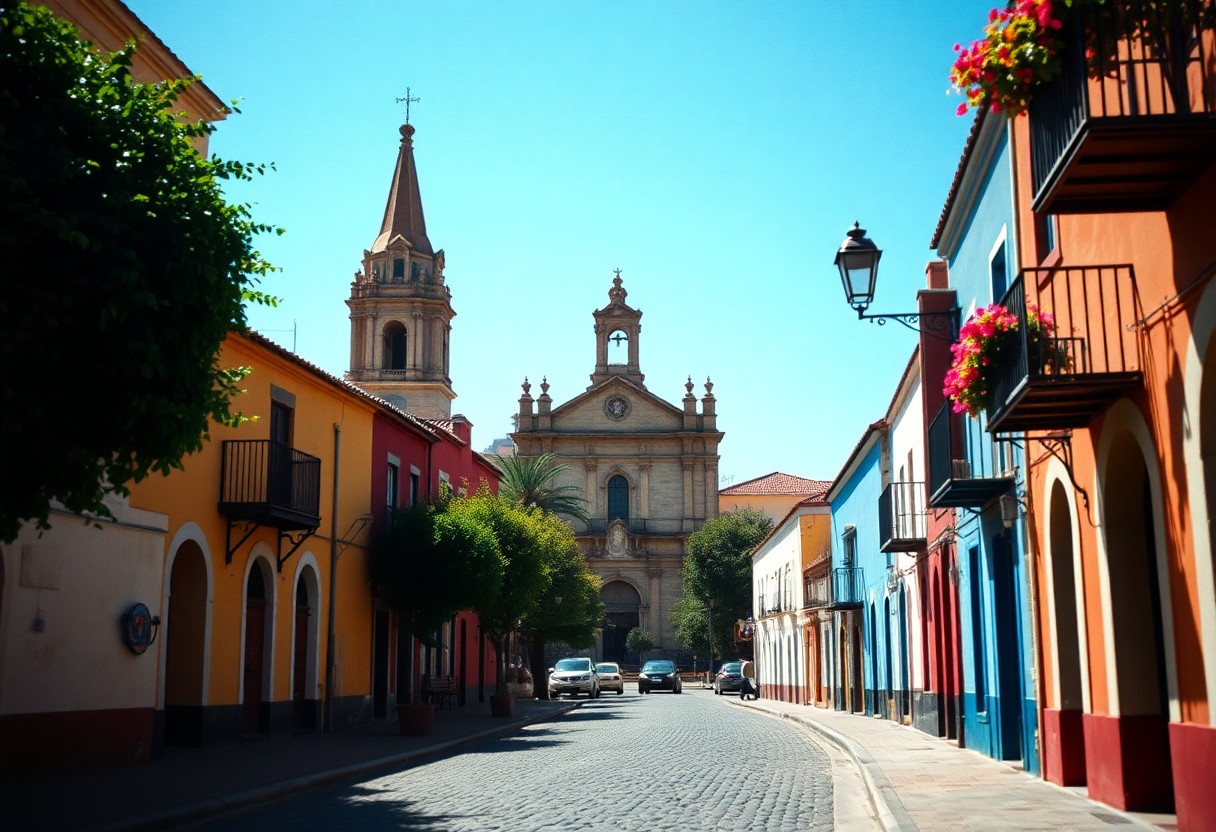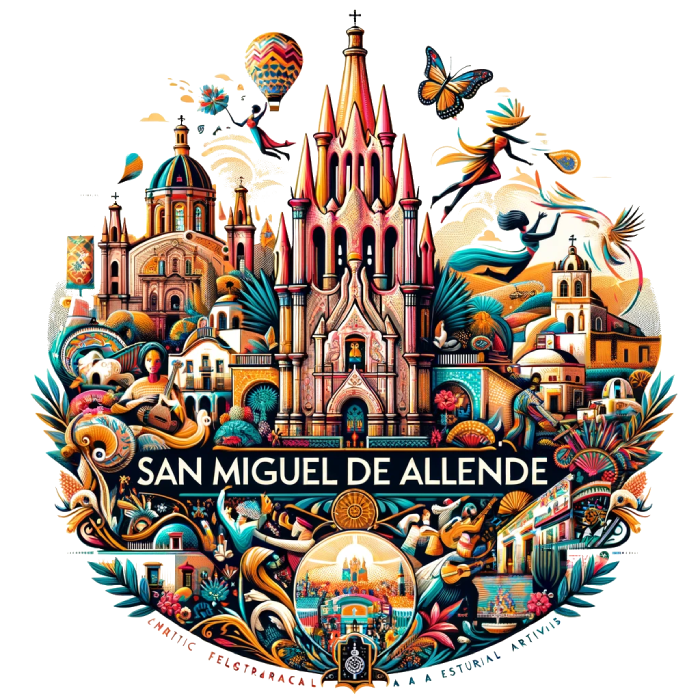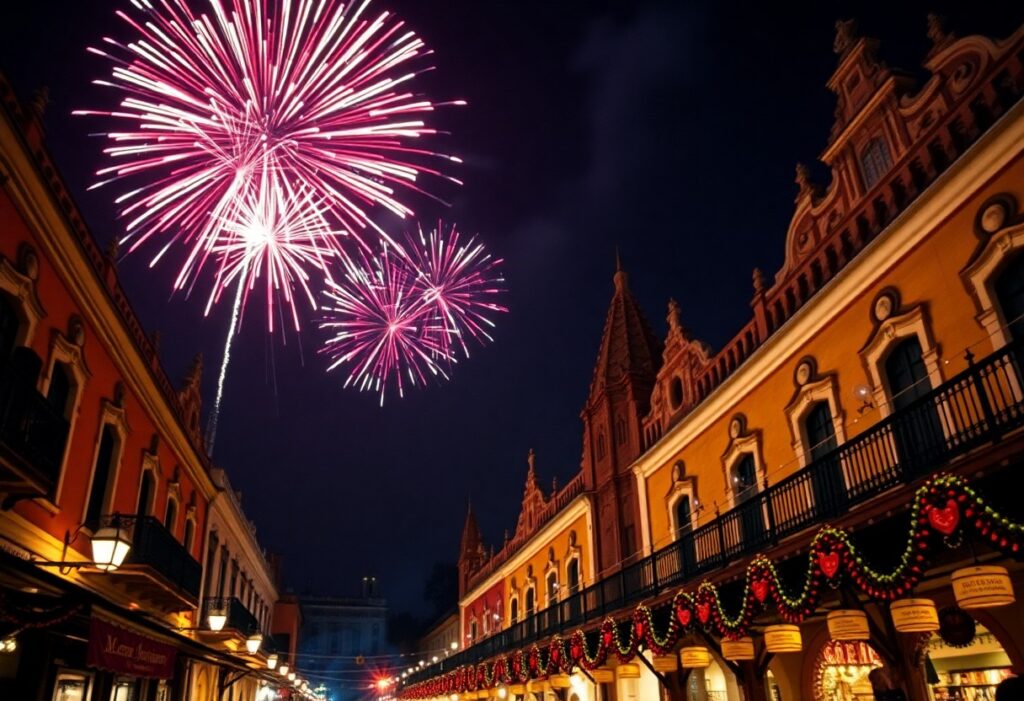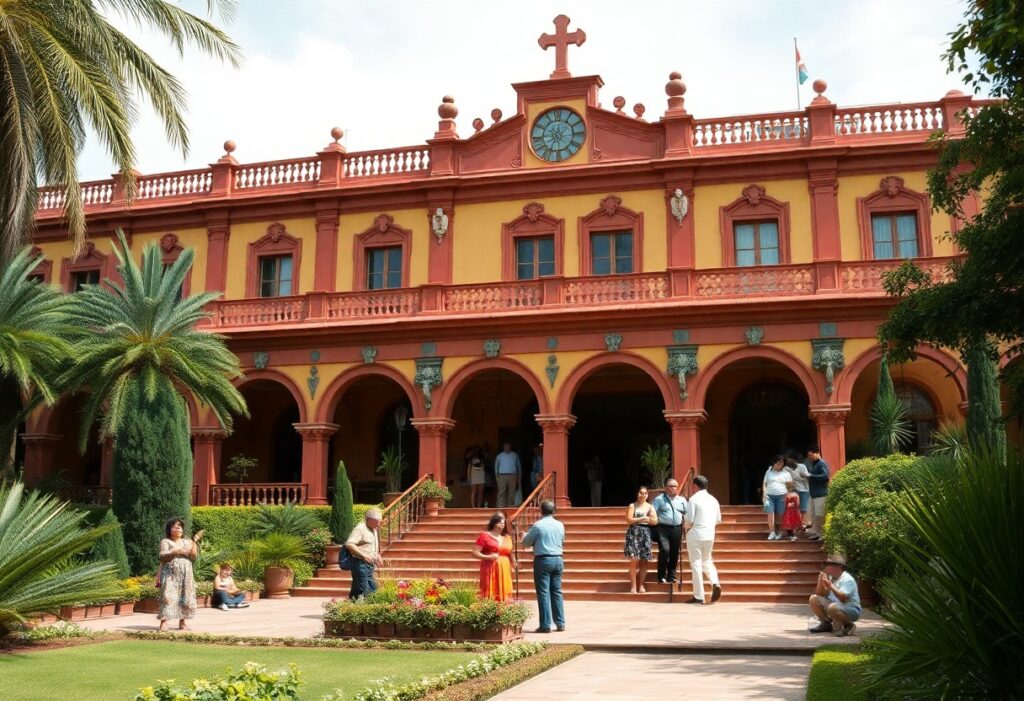Heritage preservation recognizes San Miguel de Allende as a remarkable architectural treasure that captivates you with its colonial charm and historical significance. You’ll discover why UNESCO designated this Mexican city as a World Heritage Site in 2008, highlighting its extraordinary cultural landscape and impeccably preserved Spanish colonial architecture. When you explore its cobblestone streets, you’ll be immersed in a living museum where vibrant colors, stunning baroque buildings, and rich artistic traditions converge. The city’s exceptional architectural integrity and profound historical importance make it a must-visit destination that offers an unparalleled glimpse into Mexico’s cultural evolution.
Historical Context of San Miguel de Allende
While San Miguel de Allende boasts a rich and complex history, its significance extends far beyond mere geographical boundaries. You’ll uncover a city that has been a pivotal center of cultural, political, and artistic development in Mexico, embodying centuries of transformative experiences that have shaped its unique identity and UNESCO World Heritage status.
Origins and Foundation
Below the rugged terrain of central Mexico, San Miguel was established in 1542 by Franciscan monk Fray Juan de San Miguel. Its founding strategically posits Spanish colonial interests and serves as a critical connection point between major regional settlements.
San Miguel de Allende in the Colonial Era
Besides the vibrant trade routes, San Miguel became a significant economic and cultural hub during the Spanish colonial period. You’ll observe how its strategic location facilitated commerce, cultural exchange, and architectural development that would define its future character.
Hence, San Miguel de Allende became a microcosm of colonial complexity, blending indigenous traditions with Spanish architectural and administrative practices. You’ll witness how the city developed sophisticated urban planning, elegant baroque structures, and a multicultural social fabric that distinguished it from other colonial settlements.
The City’s Role in the Mexican War of Independence
Allende, named after the revolutionary hero Ignacio Allende, played a pivotal role in Mexico’s independence movement. You’ll learn how the city became a critical center of revolutionary planning and resistance against Spanish colonial rule.
The context of the independence struggle reveals the context as more than a passive backdrop. You’ll understand how local leaders like Ignacio Allende transformed the city into a strategic revolutionary headquarters, where critical meetings, conspiracies, and resistance strategies were meticulously planned, ultimately contributing to Mexico’s liberation from Spanish control.
Architectural Significance of San Miguel de Allende
It is a remarkable testament to architecture, showcasing an extraordinary blend of historical design elements that has earned San Miguel de Allende its UNESCO World Heritage Site status. You’ll discover a cityscape where every street and building tells a story of architectural evolution, presenting a stunning visual narrative of colonial and post-colonial design principles that have preserved the city’s unique character.
Colonial Baroque Style
Behind the city’s architectural splendor lies the magnificent Colonial Baroque style, which you can observe in its most intricate details. This architectural approach characterizes many of San Miguel’s buildings, featuring ornate facades, elaborate stone carvings, and symmetrical designs that reflect the Spanish colonial influence reflecting the 18th century.
Preservation of Historical Structures
After decades of careful conservation, San Miguel de Allende has meticulously maintained its historical architectural integrity. You’ll find that local authorities and preservaLocalorked diligently to protect and restore buildings, ensuring that the city’s architectural heritage remains intact and visually stunning.
To ensure comprehensive preservation, the cityThedelines and restoration protocols. You’ll notice that restoration projects before ensuring comprehensive preservation include restoration construction techniques and authentic design elements, which help maintain the historical authenticity of each structure.
each structure’s historical authenticityural Styles
Architectural diversity in San Miguel extends beyond Baroque, incorporating elegant Neoclassical influences that you can observe in various municipal and religious buildings. The city’s architectural landscape demonstrates a sophisticated blend of European design principles adapted to local Mexican aesthetics.
Hence, the architectural evolution of San Miguel de Alural dialogue. Allende’s architectural evolution appreciates how different architectural styles have seamlessly integrated, creating a unique urban environment that reflects the city’s rich historical narrative and artistic sophistication.
Cultural Heritage
Despite its modest size, San Miguel de Allende represents a profound cultural tapestry that showcases Mexico’s rich historical legacy. You’ll discover a UNESCO World Heritage Site where colonial architecture, artistic traditions, and indigenous influences converge, creating a unique cultural landscape that preserves centuries of Mexican heritage. The city’s architectural integrity and cultural significance make it a living museum of Mexican history and artistic expression.
Local Festivals and Traditions
Participating in San Miguel de Allende’s vibParticipating, you’ll experience the city’s deep-rooted cult, which will allow you to have celebrations. From the colorful Día de los Muertos, these traditions reflect the community’s spiritual and social connections, formate the Holy Week processions, reflect the community’s spiritual continuity, and provide a profound insight into local customs.
Arts and Crafts of San Miguel de Allende
Any visitor to San Miguel will be captivated by its extraordinary artisan heritage. You’ll encounter intricate pottery, handwoven textiles, and metalwork that represent generations of artistic skill. These crafts not only serve decorative purposes but also serve decorative purposes and traditional traditions.
Miguel de Allende’s arts and crafts scene is a testament to the city’s creative ecosystem. Traditional techniques passed down through generations coexist with contemporary artistic innovations. You’ll find workshops where artisans create everything from delicate ceramic pieces to complex textile designs, each representing a unique blend of indigenous and colonial influences.
Influence of Prominent Artists and Intellectuals
Traditions of artistic excellence have been culNumerous influential creators have cultivated traditions in San Miguel who transformed the city into a global cultural destination, contributing to its reputation as a center of creativity and inspiration.
The artistic legacy of San Miguel de Allende extends far beyond local boundaries. You’ll discover how international artists were drawn to the city’s unique atmosphere, establishing art schools and creating a cosmopolitan cultural environment. Prominent figures like Diego Rivera and Frida Kahlo contributed to making San Miguel a significant artistic hub that continues to attract creative minds from around the world attracting creative minds worldwide. San Miguel de Allende’s urban design reflects a masterful colonial Spanish architectural approach. You’ll discover a meticulously planned city grid harmonizing architectural elements with topographical features. The layout demonstrates sophisticated urban planning principles that have preserved its historical integrity, making it a remarkable example of architectural conservation. You can observe how the city’s streets and buildings create a cohesive urban landscape that respects both historical and geographical contexts.
Thermal Plaza and Its Significance
Above all, the Jardín Principal represents the heart of San Miguel de Allende’s social and architectural identity. You’ll find this central plaza serves as a vibrThisace that embodies the city’s cultural essence. Its design reflects traditional Spanish colonial urban planning, where you can experience the intricate relationship between public space and community interaction. The plaza’s surrounding buildings and architectural elements create a stunning visual composition that attracts visitors and locals alike.
Integration of Nature and Urban Space
Against the backdrop of architectural magnificence, Sande seamlessly blends natural elements with urban design. You’ll notice how green spaces, courtyards, and gardens are strategically incorporated into the city’s layout. This integration creates breathtaking visual harmony between built environments and natural landscapes, offering a unique urban experience that celebrates ecological balance.
Integrating nature within San Miguel de Allende’s urban fabric goes beyond aesthetic considerations. You’ll discover how indigenous landscaping techniques and colonial design principles work together to create microclimates, provide shade, and enhance urban livability. Native plant species, carefully placed vegetation, and innovative architectural approaches demonstrate a sophisticated understanding of environmental design.
Walkable Streets and Community Spaces
About San Miguel de Allende’s urban design, you’ll appreciate its pedestrian-friendly infrastructure. Narrow, cobblestone streets and compact urban blocks encourage walking and social interaction. The city’s layout prioritizes human-scale design, allowing you to explore its charming neighborhoods comfortably and safely.
Layout considerations in San Miguel de Allende extend far beyond mere functionality. You’ll find that the city’s street design promotes community engagement. Narrow streets with minimal vehicular traffic create opportunities for spontaneous interactions, while architectural elements like balconies, doorways, and public squares facilitate a sense of shared urban experience. This design transforms everyday movement into a rich, communal narrative.
Religious Significance
Many religious traditions converge in San Miguel de Allende, creating a spiritual landscape that reflects the city’s deep cultural heritage. You’ll discover how religion has profoundly shaped the urban fabric, influencing architecture, social interactions, and community life throughout centuries of historical development.
Historical Churches and Their Architectures
Before the Spanish arrival, indigenous religious practices dominated the region. You’ll be impressed by the stunning colonial-era churches that now define San Miguel’s architectural identity, showcasing baroque, neoclassical, and indigenous architectural styles that blend seamlessly across the cityscape.
The Role of Religion in Daily Life
Behind every street corner, you’ll witness how religious beliefs permeate San Miguel’s social dynamics. Your interactions will reveal a profoundly spiritual community where faith influences daily routines, social connections, and personal identities.
Religious practices in San Miguel extend far beyond formal worship. You’ll observe how faith shapes family structures, community gatherings, and personal decision-making processes, creating a holistic approach to spiritual life that integrates seamlessly with social interactions and cultural traditions.
Festivals and Religious Celebrations
Historical religious festivals transform San Miguel into a vibrant celebration of spiritual heritage. You’ll experience extraordinary events like Holy Week and Day of the Dead, where traditional rituals and community participation create profound cultural experiences.
Further exploring San Miguel’s religious celebrations reveals intricate connections between spiritual practices and cultural identity. You’ll witness how these festivals serve not just as religious observances but as powerful expressions of community solidarity, artistic creativity, and cultural preservation, attracting visitors worldwide who seek to understand the city’s rich spiritual traditions.

Preservation Efforts
All preservation efforts in San Miguel de Allende are designed to maintain the exceptional architectural and cultural integrity of this UNESCO World Heritage Site. You’ll find comprehensive strategies that protect the city’s historic urban landscape, ensuring its unique character remains intact for future generations.
Local and National Preservation Laws
One significant aspect of San Miguel’s preservation is the robust legal framework established by Mexican federal and local governments. You can observe strict regulations that protect historic buildings, control urban development, and mandate specific restoration standards for properties within the heritage zone.
Role of Non-Governmental Organizations
The conservation of San Miguel involves numerous non-governmental organizations dedicated to heritage protection. You’ll discover these groups actively work to advocate for the city’s architectural treasures, collaborating with local authorities to prevent potential cultural degradation.
Role of NGOs extends beyond mere preservation. The role organizations conduct extensive research, provide technical expertise, and mobilize community resources to support San Miguel’s heritage conservation. You’ll find they organize workshops and fundraising; they also offer educational programs that raise awareness about the city’s historical significance.
Community Involvement in Heritage Protection
At the heart of San Miguel’s preservation are its residents, who actively participate in protecting their cultural landscape. You’ll witness community members engaging in restoration projects, maintaining traditional architectural elements, and promoting sustainable tourism practices.
Preserving San Miguel is a collective endeavor where residents understand their role as guardians of a living heritage. You’ll see how local communities collaborate with experts, share traditional knowledge, and invest personal resources to maintain the city’s architectural and cultural authenticity, making heritage protection a shared responsibility.
UNESCO’s Criteria for World Heritage Designation
Not all locations qualify for UNESCO World Heritage status. UNESCO evaluates sites based on six criteria, requiring destinations to demonstrate exceptional cultural, historical, or natural significance. You’ll find that San Miguel de Allende meets standards, highlighting its extraordinary global importance. Each criterion represents a unique aspect of the city’s outstanding universal value, reflecting its profound historical and architectural significance.
Criteria II: Influence on Architecture
Among the most compelling aspects of San Miguel de Aectural influeAllende’s most captivating elements will discover how the city’s distinctive architectural style has significantly impacted urban design and preservation techniques. The blend of colonial Spanish and indigenous Mexican architectural elements creates a unique visual narrative that has inspired architects and urban planners worldwide.
Criteria IV: Exemplification of Cultural Traditions
Before UNESCO’s designation, San Miguel de Allende was already recognized for preserving exceptional cultural traditions. You’ll appreciate how the city maintains its historical urban fabric, representing a remarkable example of colonial town planning. The architectural ensemble reflects centuries of cultural evolution, showcasing intricate design principles that have survived through generations.
Criteria IV researches San Miguel de Allende’s cresearchignificance deeper. The city represents a living museum, Theitage, with its well-preserved colonial structures, vibrant artistic community, and continuous cultural practices. The urban landscape tells a comprehensive architectural and social development story, demonstrating how traditional building techniques and spatial arrangements have maintained their integrity over centuries.
Criteria VI: Importance of Historical Events
Criteria VI highlights San Miguel de Allende’s profound historical importance. You’ll explore how the city was pivotal in Mexico’s independence movement, serving as a critical location for revolutionary discussions and strategic planning. The city’s historical narrative is deeply intertwined with national identity and transformative social movements.
Further exploration reveals the city’s multifaceted historical significance. You’ll discover San Miguel de Allende’s role in shaping Mexico’s cultural and political landscape. The town was a passive witness to historical events and an active participant in national transformation. Its intellectual and artistic communities have consistently contributed to broader Mexican cultural narratives, making it a symbol of resilience, creativity, and social change.

The Impact of UNESCO Designation
After receiving UNESCO World Heritage status, San Miguel de Allende experienced transformative changes that elevated its global significance. You’ll find that this designation not only recoThistorical importance but also opened doors to international recognition and preservation efforts. The UNESCO title strongly endorsed San Miguel’s cultural and architectural uniqueness, highlighting its exceptional value to the world.
Economic Growth and Tourism
Above all, the UNESCO designation sparked a significant tourism boom for San Miguel de Allende. You can observe how international visitors becaInternationalcity’s UNESCO-certified charm, leading to substantial economic opportunities. The recognition brought increased investment and global attention, transforming the local economy and creating new avenues for cultural exchange.
Increased Global Awareness
To understand the impact, you’ll see how the UNESCO title dramatically raised San Miguel’s international profile. The designation became a global spotlight on the city’s rich heritage, attracting artists, historians, and cultural enthusiasts worldwide.
But beyond the initial recognition, the UNESCO status created a deeper narrative about San Miguel’s cultural significance. You’ll discover how the designation became a powerful storytelling tool, sharing the city’s historical depth and architectural beauty with a global audience, ultimately positioning it as a must-visit cultural destination.
Challenges of Preservation Amidst Growth
One significant consequence of the UNESCO designation was the delicate balance between preservation and development. You’ll notice the increasing pressure to maintain the city’s historical integrity while accommodating growing tourism and economic opportunities.
UNESCO World Heritage status brought opportunities and challenges for San Miguel de Allende. You’ll understand that preserving the city’s architectural authenticity has become complex, requiring careful urban planning and conservation strategies to protect its unique cultural landscape while allowing sustainable growth.
Here’s the content for the blog post section on Tourism in San Miguel de Allende:
Tourism in San Miguel de Allende
Your visit to San Miguel de Allende reveals a thriving tourism destination that attracts thousands of international travelers annually. The city’s unique blend of colonial architecture, vibrant arts scene, and cultural richness makes it a premier Mexican travel experience. The tourism industry here is not just The driver but also a significant contributor to the city’s global reputation as a must-visit destination.
Major Tourist Attractions
For travelers, San Miguel de Allende offers clear attractions. You can explore the iconic Parroquia de San M for travelers Arcángel, wander through the historic Jardín Principal, visit world-class art galleries, and enjoy the city’s renowned cultural festivals. The architectural beauty and artistic heritage make every corner of this city a potential tourist highlight.
Effects of Tourism on Local Culture
On one hand, tourism has transformed San Miguel de Allende’s economic landscape, bringing significant economic opportunities for residents. The influx of international visitors has created jobs, stimulated local businesses, and brought global recognition to the city’s unique cultural identity.
Tourist interactions have deeply influenced San Miguel de Allende’s social dynamics. The continuous cultural exchange has enriched and challenged traditional community structures, creating a complex relationship between residents and international visitors. This interaction has increased cultural awareness, economic diversification, and a more globally connected community.
Sustainable Tourism Practices
San Miguel de Allende is pioneering sustainable tourism strategies by implementing innovative approaches. You’ll find eco-friendly accommodations, community-based tourism initiatives, and conservation programs that aim to preserve the city’s cultural and environmental heritage while supporting local economic development.
Allende’s commitment to sustainable tourism goes beyond mere environmental considerations. The city has developed comprehensive strategies integrating local community needs with tourism development. This approach includes preserving architectural integrity, supporting local artisans, promoting cultural education, and ensuring that tourism benefits extend to all community members, not just those directly involved in the tourism sector.
How to Experience San Miguel de Allende’s Heritage
For an immersive journey into San Miguel de Allende’s rich cultural landscape, you’ll want to explore the city’s UNESCO World Heritage Site status through multiple perspectives. Your experience can blend historical insights, architectural wonders, and local traditions, offering a comprehensive understanding of this extraordinary Mexican destination. By engaging with various exploration methods, you’ll uncover the layers of heritage that make San Miguel de Allende a truly unique cultural treasure.
Guided Tours vgenuinelylf-Exploration
One approach to discovering San Miguel’s heritage involves balancing structured guided tours with personal exploration. Professional guides can provide professional insider knowledge, while independent wandering allows for spontaneous discoveries. Each method offers unique advantages: guided tours give you professional insights, while self-exploration lets you create your narrative through the city’s picturesque streets and historic sites.
Key Sites and Landmarks
Self-exploration of San Miguel’s landmarks reveals a stunning architectural tapestry. You’ll encounter the Parroquia de San Miguel Arcángel, with its iconic pink spires, the historic Jardín Principal, and numerous colonial-era buildings that showcase the city’s remarkable preservation. Each site tells a story of artistic and cultural significance, inviting you to step back in time and experience the city’s rich historical narrative.
Indeed, San Miguel’s landmarks represent more than mere architectural monuments. The Templo de San Francisco, with its intricate Baroque design, exemplifies the city’s artistic heritage. The Instituto Allende, housed in a former hacienda, offers insights into local art and culture. You’ll discover how each landmark connects to the broader narrative of Mexican history, from colonial times to the present day, providing a comprehensive cultural experience.
Recommendations for Cultural Engagement
Any visitor seeking a deep cultural connection should engage directly with local traditions. You’ll want to participate in festivals, visit artisan workshops, and interact with residents. Language immersion and cultural workshops can provide authentic experiences beyond typical tourist activities, allowing you to truly understand the spirit of San Miguel de Allende.
A comprehensive cultural engagement strategy involves more than passive observation. You’ll benefit from attending local art exhibitions, joining cooking classes that explore traditional Mexican cuisine, and participating in community events. These experiences offer profound insights into the city’s living culture, connecting you with the vibrant social fabric that makes San Miguel de Allende a world-renowned cultural destination.

The Role of Education in Heritage Appreciation
Once again, education is a powerful catalyst in preserving San Miguel de Allende’s rich cultural heritage. You’ll discover that understanding the city’s historical significance goes beyond mere observation, requiring active engagement and learning. By fostering educational initiatives, the community ensures that cultural knowledge is transmitted across generations, maintaining the integrity of this UNESCO World Heritage Site.
Educational Programs and Workshops
Any educational program in San Miguel de Allende aims to illuminate the city’s architectural and cultural treasures. You can participate in workshops that explore tWorkshopsrratives and preservation techniques. These interactive sessions provide insights into the unique heritage of San Miguel de Allende, a globally recognized destination.
Collaboration with Educational Institutions
Programs connecting local schools and universities play a vital role in heritage conservation. You’ll find collaborative efforts that integrate cultural education into academic curricula, ensuring students develop a profound appreciation for San Miguel’s historical landscape. These partnerships create a sustainable approach to preserving the city’s cultural identity.
Further collaboration extends beyond local boundaries, involving national and international educational institutions. You can witness research projects, student exchanges, and scholarly investigations researching San Miguel’s architectural, social, and cultural dimensions. These academic endeavors contribute significantly to documenting and understanding the city’s exceptional universal value.
Raising Awareness among Residents and Visitors
The role of awareness programs cannot be The role of heritage preservation. Heritage preservation, you’ll encounter interactive centers and multimedia presentations that will illuminate the city’s historical significance. These initiatives transform passive observation into active engagement, encouraging residents and visitors to become stewards of San Miguel’s cultural legacy.
Education about heritage is a continuous journey that transforms perception. You will discover that raising awareness involves more than presenting historical facts; it’s about creating emotional connections. Through storytelling, interactive exhibits, and community events, San Miguel de Allende invites you to become part of its living history, ensuring its cultural narrative remains vibrant and meaningful for future generations.
Cultural Exchange and Global Connections
San Miguel de Allende is now a vibrant nexus of international cultural interaction where historical significance meets contemporary global dialogue. You’ll discover how this city transcends traditional boundaries, creating a unique space where diverse traditions, artistic expressions, and human experiences converge. This makes it a truly remarkable UNESCO World Her. This makeste that celebrates global interconnectedness.
San Miguel de Allende’s International Community
At the heart of San Miguel de Allende lies a remarkably diverse international population that transforms the city into a microcosm of global culture. You’ll find artists, writers, and professionals. Artistsrldwhas its enchanting atmosphere and contributes to a cosmopolitan environment that defies traditional cultural boundaries.
The Role of Expatriates in Local Culture
Above all, expatriates in San Miguel de Allende play a transformative role in cultural preservation and innovation. You’ll witness how these international residents engage deeply with local traditions, supporting artisan crafts, participating in community projects, and bringing fresh perspectives that enhance the city’s cultural landscape.
Also, expatriates contribute significantly beyond mere economic impact. You’ll observe their involvement in educational initiatives, art programs, and social welfare projects that benefit local communities, creating a symbiotic relationship of mutual respect and collaborative growth.
Cultural Festivals Celebrating Diversity
An array of vibrant festivals in San Miguel de Allende exemplifies the city’s commitment to cultural exemplify. You’ll experience events that blend Indigenous Events influences, creating a dynamic platform for cultural exchange and mutual understanding.
Community festivals in San Miguel de Allende represent more than entertainment; they are potent mechanisms of cultural dialogue. You’ll find these events serve as bridges between social groups, fostering understanding, respect, and shared experiences that transcend linguistic and national boundaries.
Challenges Facing San Miguel de Allende
San Miguel de Allende confronts significant preservation challenges to preserve its UNESCO World Heritage status. You’ll find the city balancing it’s historical the city must balance pressures, requiring careful management of tourism, infrastructure, and cultural authenticity. These challenges threaten the delicate ecosystem of this internationally recognized architectural gem, demanding strategic approaches to maintain its unique character while adapting to maintain rare needs.
Urban Development vs. Heritage Preservation
Besides the city’s historical charm, urban development poses a substantial risk to architectural integrity. You’ll observe increasing pressures to modernize infrastructure while maintaining strict preservation guidelines. This delicate balance requires sophisticated urban planning that respects historical structures, ensuring new constructions complement the existing colonial aesthetic without compromising the city’s UNESCO-designated architectural heritage.
Environmental Impact of Tourism
Around 2 million tourists visit San Miguel de Allende annually, creating significant environmental strain. You’ll notice increased waste management challenges, water consumption pressures, and ecological disruption. The tourism model must evolve to minimize environmental degradation while sustaining the local economy.
The environmental consequences of tourism extend beyond immediate waste concerns. You’ll find that increased visitor numbers leadIncreasedsions, stress on local water resources, and potential disruption of native ecosystems. Sustainable tourism strategies become vital in mitigating these long-term environmental impacts, requiring comprehensive planning and community engagement.
Balancing Modern Needs with Historical Integrity
Before implementing urban modifications, city planners must carefully consider preserving historical character. You’ll need to navigate complex regulations that must architectural heritage while allowing necessary infrastructure improvements. This delicate process requires innovative solutions that respect San Miguel’s historical significance.
Also, the challenge of modernization goes beyond physical infrastructure. You’ll discover that maintaining cultural authenticity while introducing contemporary amenities requires a nuanced approach. Innovative design strategies that blend traditional aesthetics with modern functionality can help San Miguel de Allende preserve its unique identity while meeting current urban requirements.
Final Thoughts
Despite its small size, San Miguel de Allende represents a living testament to cultural preservation. You will find that this UNESCO World Heritage Site offers more than picturesque landscapes; it embodies architectural brilliance and historical significance. Your exploration reveals a destination where colonial charm meets artistic innovation, making it uniquely compelling for travelers. The city’s recognition by UNESCO underscores its exceptional universal value, inviting you to experience a place where every cobblestone street and colorful facade tells a profound story of Mexican heritage and architectural excellence.
FAQ
What architectural features make San Miguel de Allende a UNESCO World Heritage Site?
San Miguel de Allende showcases exceptional colonial Spanish architecture from the 16th to 18th centuries. The city’s historic center features well-preserved baroque and neoclassical buildings with intricate facades, colorful stone structures, and a harmonious urban layout. The Parish of San Miguel Arcángel, with its distinctive pink stone gothic-style tower, is a prime example of the city’s architectural significance. UNESCO recognized the town’s remarkable architectural integrity and historical urban design 2008.
How does San Miguel de Allende represent cultural heritage and historical importance?
The city played a pivotal role in Mexican independence movements and preserved rich cultural traditions. Its historic center demonstrates exceptional Spanish colonial urban planning preservation, with narrow cobblestone streets, central plazas, and historic buildings that reflect complex multicultural interactions. San Miguel de Allende became a critical center for artistic and intellectual development, attracting international artists and preserving indigenous and colonial cultural expressions.
What specific criteria did UNESCO consider when designating San Miguel de Allende as a World Heritage Site?
UNESCO evaluated San Miguel de Allende based on multiple cultural and architectural criteria. The organization assessed the city’s outstanding universal value, including its remarkable architectural ensemble, historical continuity, and cultural significance. Specific considerations included the city’s urban landscape, architectural authenticity, preservation of historic structures, and representation of colonial urban design principles. The site exemplifies Spanish colonial urban development and maintains high architectural and cultural integrity.





San Miguel de Allende truly feels like stepping into a living tapestry of history and culture. I find it fascinating how its blend of architectural beauty and historical significance not only captivates tourists but also inspires local and international artists alike. When wandering through its charming streets, one cannot help but be struck by the vibrant murals that tell stories of both past and present, bridging generations through art.
What a beautifully written piece! Your exploration of San Miguel de Allende really captures the essence of why this city feels like stepping back in time while simultaneously being vibrant and alive with cultural expression. I remember my visit there a couple of years ago; wandering those cobblestone streets felt like navigating through a work of art. Each corner revealed something new—a brightly painted doorway, an artistic mural, or the soft sound of a mariachi band playing nearby.
Your depiction of San Miguel de Allende captures the essence of its architectural beauty and cultural depth. However, I find it interesting to consider how the drive for heritage preservation can sometimes lead to conflicts between the ideals of conservation and the realities of modern living. For instance, as tourism increases, locals often face pressure from rising costs and an influx of businesses that may not align with the city’s traditional character.
Your description of San Miguel de Allende vividly brings to life the unique blend of history and artistry that permeates the city. It’s fascinating to think about how UNESCO’s recognition in 2008 transformed not just the city’s profile but also how we perceive our responsibility toward heritage preservation globally. This certainly raises important discussions about the balance between tourism and conservation.
You’ve touched on a really important aspect of what makes San Miguel de Allende so special. The UNESCO designation did more than just put a spotlight on the city; it sparked a conversation around what it means to protect our cultural heritage in a world that’s often caught up in the rush of modernity and tourism. It’s interesting to think about how this recognition encourages not just local pride but also a shared global responsibility.
I loved how you highlighted San Miguel de Allende’s architectural treasures and its recognition as a UNESCO World Heritage Site. It truly does feel like stepping into a time capsule when you wander through those cobblestone streets. Each vibrant façade tells its own story, and I find it fascinating how the city marries colonial history with contemporary artistic expressions. I recently read about local artists and artisans who continue to thrive there, blending traditional crafts with modern influences. It’s a living example of how heritage not only protects the past but also nourishes the present creative landscape.
Your exploration of San Miguel de Allende’s heritage preservation beautifully highlights the city’s intricate blend of colonial charm and historical significance. As someone who has had the privilege of visiting, I can attest to the transformative experience of wandering through its cobblestone streets, where every corner seems steeped in stories of the past.
You’ve perfectly captured the colonial charm of San Miguel de Allende! It’s like walking through a vibrant postcard where every corner begs for a selfie (or three). I remember my first visit; I was convinced I’d stepped into a time machine, especially when I saw those baroque facades competing for attention.